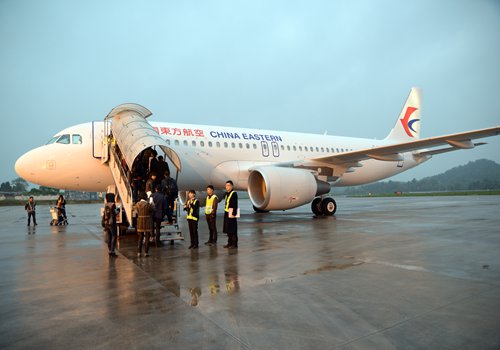Eager to expand, airlines challenged by weakening yuan, rising fuel prices
Uncertainties cloud 2017

Passengers board a China Eastern Airlines jet in Zunyi, Southwest China's Guizhou Province. Photo: CFP
2016 was not an easy year for the global aviation industry, as nearly a dozen of air accidents dampened enthusiasm for air travel.
Nonetheless, the industry still had a record year for profits. The International Air Transport Association (IATA) has estimated the industry's global net profit amounted to $35.6 billion in 2016, up from $35.3 billion in 2015.
Even though rising oil prices will make profits harder to come by in 2017, the Chinese aviation industry will undergo major changes this year as airlines strive to fly more and fly farther.
Crowded sky
Certainly, there have been complaints that the sky is getting crowded as global airlines add aircraft to their fleets, but the sky is only going to get more crowded in 2017 as the airlines of China, the world's second largest aviation market in terms of market size, expand.
The expansion of new model airlines and progressive liberalization in the region is intensifying already strong competition.
China Southern Airlines announced on Monday that it will enhance the construction of its Beijing hub in 2017, and it plans to introduce more than 200 aircraft at the new airport so it can fly more routes both at home and abroad.
Its plans in Beijing have put it in cutthroat competition with Air China, which has been cultivating the Beijing market for years. Still, China's Southern has not neglected its base hub of Guangzhou, capital of South China's Guangdong Province. It plans to add more international flights from the city and its neighbor Shenzhen, also in Guangdong.
China Eastern Airlines, which has more than 600 aircraft, flies to more than 80 percent of Chinese cities and plans to extend its network to more than 1,062 cities across the globe. The airline has touted that its transport capacities to North America, Europe and Australia increased by 62.3 percent, 25.5 percent, and 39.5 percent year-on-year respectively in 2016.
The increases are the result of China Eastern's expanded fleets. In April 2016, the airline signed deals with both Boeing and Airbus, and vowed to introduce 15 787-9s and 20 A350-900s, which will provide more advanced and adequate capacity.
Data from aviation news portal CAPA showed Chinese carriers were expected to open 51 continental routes from 2014 to 2017, compared with only four Chinese carriers opening continental routes in 2006.
In 2017 alone, eight Chinese airlines will be flying continental flights. It should be noted that Chinese carriers account for half of the destinations in the Asian market.
Crude and currency
While airline industry profits are expected to have reached a cyclical peak of $35.6 billion in 2016, the IATA expects a soft landing in profitable territory in 2017, with industry-wide net profit of $29.8 billion. That would make 2017 the eighth straight year of aggregate airline profitability.
However, expected higher oil prices will have the biggest impact on the outlook for profits in 2017.
In 2016, the average price of Brent crude oil, the international benchmark, was $44.60 a barrel. The price is expected to increase to $55 in 2017. The change is expected to push the price of jet fuel from $52.10 a barrel in 2016 to $64.90 a barrel in 2017, making fuel account for 18.7 percent of the industry's costs in 2017, which is significantly below the recent peak of 33.2 percent in 2012-2013, the IATA said.
Beside rising fuel prices, the depreciation of the yuan also casts a shadow over the outlook for airline profits in 2017.
Aircraft are primarily priced in US dollars, so dollar debts are airlines' largest liability. When the yuan depreciates against the dollar, airlines incur foreign exchange losses. In 2015, domestic airlines experience some financial turbulence from the depreciating yuan, causing the country's four major airlines to take 17.62 billion yuan ($2.54 billion) in losses - an amount equal to their combined profits of 18.16 billion yuan for the entire year.
Although the airlines have not yet released their annual financial reports for 2016, profits will be limited by the depreciation of the currency over the course of the year.
Reform in the pipeline
China Southern announced on Monday that it will pursue mixed-ownership reform to bring in outside capital and expand its business by increasing investment in new emerging sectors.
China Southern's mixed-ownership reform is part of China's reform agenda for State-owned enterprises (SOEs) to improve efficiency.
China set mixed-ownership reform for SOEs in seven sectors, including electricity, oil and civil aviation, as its top priority for 2017, according to a statement by the State Council, China's cabinet, in December 2016.
In 2016, China Eastern was the first State-owned airline to announce mixed-ownership reform, according to media reports.
There is no doubt that introducing outside capital can make companies more market-oriented, and it may urge more airlines to embark on mixed-ownership reform, though the results will depend on how far the reforms can go.

